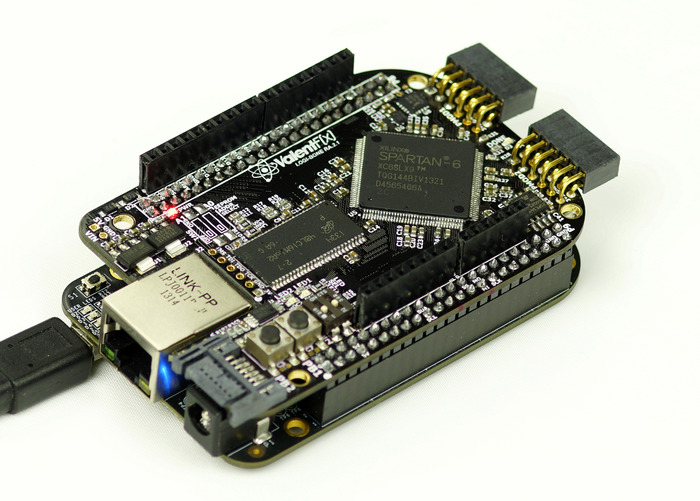By Tara Stratton
As working professionals, Michael Jones, Jonathan Piat and their
team at Valent F(x) know that interfacing with FPGA boards can be a
clunky and cumbersome process. With these complexities of electronic
design in mind, they strove to devise a more user-friendly,
plug-and-play method to, as Michael put it, make even students and
hobbyists smile.
As a result, the folks at Valent F(x) developed the LOGi family of
FPGA development boards. According to Michael, these boards were
created with a dual-use purpose: to limit the sharp learning curve
associated with FPGA development and to enable the unification of
existing hardware interfaces and open-source development platforms,
including our own BeagleBone Black.
Valent F(x) claims that they help their customers overcome various
challenges by developing open-source hardware that is easy to use,
program and interface with various existing hardware peripherals.

Image credit: Valent F(x)
The LOGi-Bone is a LOGi FPGA board that recently met with great
success on Kickstarter. The heart of the LOGi-Bonelike all of the
other LOGi-boardsis a Xilinx Spartan 6 FPGA. The LOGi-Bone has two
rows of connectors on the underside of the FPGA board that allow
users to interface with the 2×46 headers on BeagleBone Black,
based on TIs
Sitara AM335x processor. The board is also compatible with the
original BeagleBone.
The main controller is a Mac Mini mounted in a custom arcade
console. Every frame of video is rendered on this console and
streamed over Wi-Fi to reduce the number of wires needednormal
wires dont work for a POV display because they would get tangled
up from all of the spinning. Because of this challenge, all of the
brains required to run the display are mounted to the spinning part
and spin along with the display.
Other LOGi-Bone features include:
● 256 Mb SDRAM
● 2x LEDs
● 2x push buttons
● 2x DIP switches
● 1 high-bandwidth SATA connector expansion port
● 2x Digilent Inc. PMOD expansion ports supporting 59+ plug-and-play hardware modules
● 1x Arduino-compatible headers connected to the FPGA pins (3.3V only); supports more than 200+ Arduino Shield modules
● Optional GPMC, SPI or I2C port access from the BeagleBone Black
● 10x length-tuned LVDS pairs
● Bit-stream-loading interface connected to the host processor; optional bitstream FPGA self-loading from onboard Flash
The LOGi-Bone adds FPGA flexibility and capability to the
BeagleBone, allowing it to be easily morphed into endless digital
applications, said Michael. In fact, the Valent F(x) team has
already created applications for the LOGi-Bone, including a Bitcoin
miner, machine vision and autonomous vehicle and robotic
controllers. All applications are open source and available on the
LOGi repository. You can
also find videos of some their current applications on the
LOGi YouTube channel.
Valent F(x) says that they are all about user collaboration and
hope to create a community infrastructure that allows users to work
together to create unique and interesting projects. Generally,
users have strengths in one of the many facets involved in
electronics, thus making it difficult to create and finish a
project that requires a wide range of electronic functionality.
Enabling multiples users with varying skills to work together
allows multi-faceted projects to be created, with each user adding
their respective strengths to the project. Valent F(x) would love
to hear from you to know what kind of projects and applications you
would like to see created and get involved in.
Now that their Kickstarter is closed, the Valent F(x) team will
start manufacturing boards and will start fulfilling orders later
this year. Visit Valent F(x)s site
for more information on these boards or to order one of your own!

